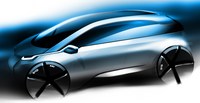BMW Releases First Sketch and Details of Electric Mega City Vehicle And Mobility of the Future Report
SEE ALSO: 2010 BMW Group Innovation Days Mobility of the Future
Complete Report:
Chapter 1. Why Electromobility?
Chapter 2. Project i.
Chapter 3. The Electric Drivetrain.
Chapter 4. Lightweight design and the LifeDrive concept.
Chapter 5. CFRP - A Material for the Future.
 |
European Senior Editor
Amsterdam Bureau
The Auto Channel
MUNICH July 2, 2010; It is no secret that the BMW Group is developing Project-i, an electrical mega city car that is due to arrive on the market in 2013. Electrical drive is not new for the Bavarian car manufacturer, who launched its first EV as early as 1969. It was an electrified BMW 1602. Over the past four decades various prototypes were built and tested.
In November 2008, the first EV with lithium-ion battery pack was launched at the eve of the LA Auto Show. In fact we could drive that car, the Mini E, in and around Beverly Hills ( Henny's MINI-E Test Drive). Last year, some 600 units were leased to private drivers in Los Angeles, New York, Tokyo, Barcelona, Berlin and Munich to learn about the use of electric vehicles is big cities.
At the beginning of 2010, BMW showed us the second electric model and an evolution of the two-seater Mini. It is the ActiveE, the electrified 1 Series Coupe, that uses a much more compact battery pack, thus leaving room for four and luggage as well. This EV will come on to the market next year, and will serve test purposes as well.
But this all will lead to the introduction in 2013 of the electrical mega city vehicle, MCV. According to Ulrich Kranz, leader of Project-I, we should not expect large numbers then, but that does not mean the MCV is not developed for series production. On the contrary, BMW’s EV will probably be marketed with a new name plate, especially introduced for zero emission models. We can expect the release of the new brand at the earliest in the beginning of 2011.
For the MCV a complete new architecture has been developed, especially for use of an electric powertrain in the rear, with rear wheel drive and a safe, low position for the battery pack.
Today, the first details and the first sketch were showed to a small group of international journalists.
The city car has a unique, so-called LifeDrive structure. The aluminum space frame will be able to absorb the energy of crashes and the cockpit structure is of super strong, light weight carbon fibre composite, CFRP, carbon fibre reinforced plastic. This material is thirty percent lighter than aluminum and fifty percent lighter than steel and has other advantages such as durability and crash resistance. Furthermore it can be easily repaired.
BMW used similar material for the structure of a prototype of the X5 in 2003. In the meantime this car has performed some 25,000 test miles and the rigidity and other qualities of the structure are still the same. Also .the roof of the 2007 M3 was made of CFRP. For the compounding of the fibre and the production of the textile BMW has teamed up with SGL Carbon. The ground breaking for the new plant in Moses Lake, WA, will be this summer. The initial investment of the joint-venture is 100 million $. The plant will employ 80 people. The ground breaking for the extension of BMW’s own plant for CFRP components in Landshut will be on July 19.
In the meantime, one prototype structure for the megacity vehicle has been crash tested from three different positions. Two according to the EuroNCAP regulations and one according to the NHTSA (side impact). After this threefold test the passenger cell was still in tact, confirming the the strength of the CFRP structure..
The lithium-ion battery pack consists of 8 modules of each 12 cells and is placed in the bottom structure of the car. The electric power train of the ActiveE will also be used for the MCV. It delivers 150 kW/ 204 hp and 162 lb-ft. of torque, but those figures may differ for the unit that will be used in the MCV. Mr. Kranz: “But since the MCV should be fun to drive, you may expect very good performance.” So expect the numbers not to be far off.
What is known now is that the electric drive unit will be placed in the rear and that the MCV will have rear wheel drive. Given the size of the prototype structure – that has no B-pillar and thus will be a three door model – and of the battery pack, the length of the MCV will probably be around 157 in. Mr. Kranz also said that the extra weight of the battery pack will be mostly compensated by the light weight design. A normal Mini weighs 1,100 kg and the Mini E has a weight of 1,460. Most of the 360 kg will be compensated. I would say, we may expect the future electric Mega City Vehicle to weigh around 1,200 kg.
A concept car of the MCV will probably bow at the Frankfurt auto show in September 2011, but it will not be before 2013, that the production version will be on the roads.
2010 BMW Group Innovation Days Mobility of the Future
Table of Contents: (Links to appropriate chapters)



